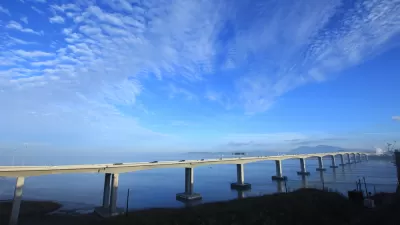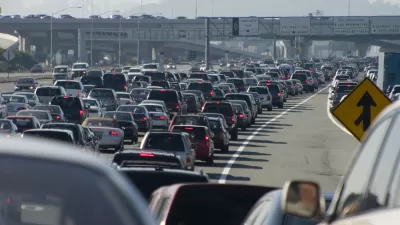In a pair of articles, four Wall Street Journal writers delve deeper into the May 24 collapse of the I-5, Skagit Valley Bridge in Washington state and its relationship to our nation's aging transportation infrastructure.
"This is not the sign of deteriorating infrastructure, this is a sign of vulnerable infrastructure," said Abolhassan Astaneh-Asl, a civil-engineering professor at the University of California, Berkeley.
Joel Millman, Zusha Elinson and Jim Carlton write that although the incident which caused two vehicles carrying three people to plunge off the four-lane interstate bridge into the Skagit River, resulting in "non-life-threatening injuries", "wasn't caused by structural flaws", according to state transportation officials, it raises "new questions about the nation's aged infrastructure".
The 1955 bridge is of a through-truss design, common for the era, that lacks the redundancy of more-modern spans—meaning that severing one truss can cause the entire bridge to collapse. (See companion piece below).
The bridge collapsed "after a flatbed truck with an oversize (but fully permitted) load hit the upper part of the bridge". In fact, the truck had a pilot car in front of it that took electronic measurements of the truck load's bridge clearance.
While a Washington state Department of Transportation spokesperson said "the bridge was structurally sound and entirely safe for travel", professor Astaneh-Asl's recommended that "today we should invest in getting these...out of the system."
In the companion piece, Kris Maher writes why these types of bridges, quite common of the era 50 years ago, are no longer built except for railroads.
The steel "through-truss" bridge has what is known as a "fracture-critical" design, which means that if any part fails the whole bridge could fail, experts said. That is what happened with the Skagit River bridge, which collapsed when a tractor-trailer took out an overhead girder, officials have determined.
"About 18,000 or 3% of the USA's 607,380 bridges are fracture-critical, lacking redundant supports". (USA Today).
As it turns out, "truck swipes" are not uncommon for bridge structures, "but in most cases it doesn't lead to a failure, said Timothy Galarnyk, who runs a St. Paul, Minn., company that conducts forensic investigations of collapses."
"This is just bad luck of where it hit and how it hit," said Lynn Peterson, State Secretary of Transportation, on the truck that struck the metal structure before the bridge's collapse. (MYNorthwest.com).
However, 'bad luck' would 'likely' not have caused a collapse in a contemporary bridge asserts Galarnyk.
"With more current technology and engineering, bridges have more flexibility," he said. "This kind of collapse would likely not occur on a modern-day bridge."
The Skagit River Bridge was not considered "structurally deficient" - it was on the less serious and larger, "structurally obsolete" list. See the May 24 post here describing deficient and obsolete bridges, and Stateline article, "66,749 Structurally Deficient Bridges" on May 24 by Melissal Maynard.
Correspondent's note: Links to both Wall Street Journal articles may not provide complete access for non-subscribers after June 01.
FULL STORY: One Link Proves Bridge's Undoing

Alabama: Trump Terminates Settlements for Black Communities Harmed By Raw Sewage
Trump deemed the landmark civil rights agreement “illegal DEI and environmental justice policy.”

Study: Maui’s Plan to Convert Vacation Rentals to Long-Term Housing Could Cause Nearly $1 Billion Economic Loss
The plan would reduce visitor accommodation by 25% resulting in 1,900 jobs lost.

Planetizen Federal Action Tracker
A weekly monitor of how Trump’s orders and actions are impacting planners and planning in America.

Restoring Northern India’s Himalayan ‘Water Temples’
Thousands of centuries-old buildings protect the region’s natural springs and serve as community wells and gathering places.

Milwaukee to Double Bike Share Stations
Bublr Bikes, one of the nation’s most successful, will add 500 new e-bikes to its system.

DC Extends Application Window for Outdoor Dining Permits
District restaurants will have until the end of November to apply, but businesses with permits in rush hour parking lanes must end operations on July 31.
Urban Design for Planners 1: Software Tools
This six-course series explores essential urban design concepts using open source software and equips planners with the tools they need to participate fully in the urban design process.
Planning for Universal Design
Learn the tools for implementing Universal Design in planning regulations.
Caltrans
Smith Gee Studio
Institute for Housing and Urban Development Studies (IHS)
City of Grandview
Harvard GSD Executive Education
Toledo-Lucas County Plan Commissions
Salt Lake City
NYU Wagner Graduate School of Public Service




























